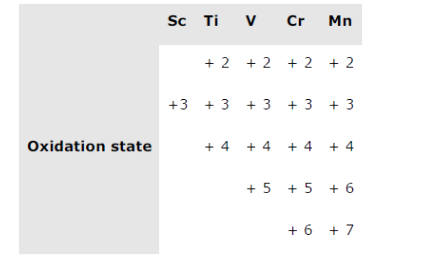Explain briefly how state become more and more stable in the first half of the first row transition elements with increasing atomic number?
The oxidation states displayed by the first half of the first row of transition metals are given in the table below.  It can be easily observed that except Sc, all others metals display +2 oxidation state. Also, on moving from Sc to Mn, the atomic number increases from 21 to 25. This means the number of electrons in the 3d-orbital also increases from 1 to 5.
It can be easily observed that except Sc, all others metals display +2 oxidation state. Also, on moving from Sc to Mn, the atomic number increases from 21 to 25. This means the number of electrons in the 3d-orbital also increases from 1 to 5.
Sc (=2)
Ti (+2)
V (+2)
Cr (+2)
Mn (+) +2 oxidation state is attained by the loss of the two 4s electrons by these metals. Since the number of d electrons in (+2) state also increases from Ti(+2) to Mn(+ 2), the stability of +2 state increases (as d-orbital is becoming more and more half-filled). Mn (+2) has electrons (that is half-filled d shell, which is highly stable).
Topper's Solved these Questions
Similar Questions
Explain briefly how +2 state become more and stable in the first half of the first row transition elements with increasing atomic number?
View SolutionExplain briefly how +2 state becomes more and more stable in the first half of the first row transition elements with increasing atomic number ?
View Solution
Knowledge Check
- Question 1 - Select One
Irregular trend in the standard reduction potential value of first row transition elements is due to
Aregular variation of first and second row enthalpiesBirregular variation of sublimation enthalpiesCregular variation of sublimation enthalpiesDincrease in number of unpaired electrons - Question 2 - Select One
The stable oxidation state likely to be shown by first row transition metals is
ACr3+BV3+CCo4+DMn7+ - Question 3 - Select One
Which of the following has the highest melting point in the first row transition elements ?
AVBMoCWDCr
Explain briefly how +2 state become more and stable in the first half of the first row transition elements with increasing atomic number?
View SolutionAssign reason for each of the following statement:
(i) The largest number of oxidation states are exhibited by the elements in their row transition elements.
(ii) The atomic radii decrease in Size with the increasing atomic number in the lanthanoid seriesView SolutionHow many elements are present in the first transition series ?
View SolutionIrregular trend in the standard reduction potential value of first row transition elements is due to
View SolutionIn which pair second ions is more stable than first ?
 View Solution
View Solution
